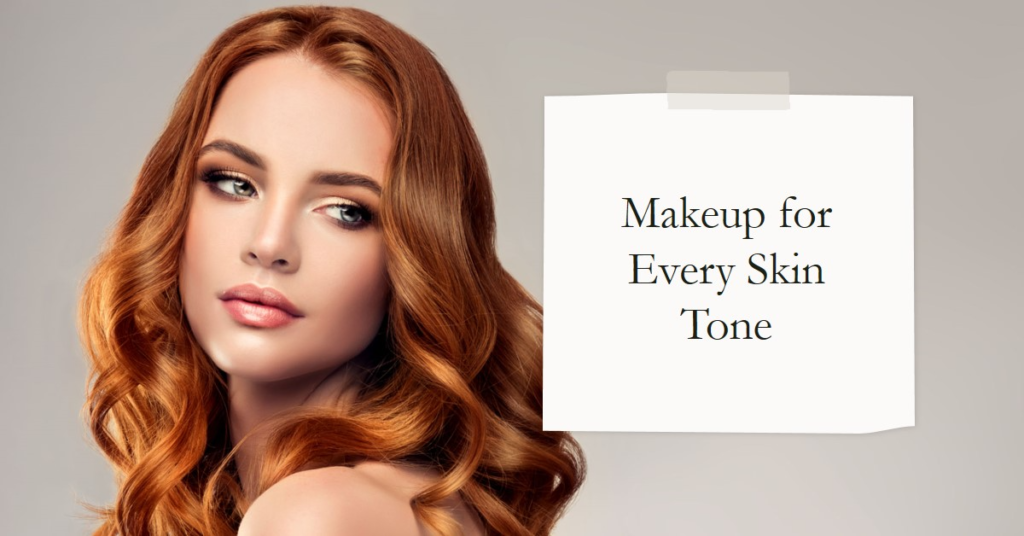Makeup is one of the most fun and creative ways we can express ourselves. But when it comes to finding a makeup look that flatters our skin tone, it can get a bit tricky. With so many different shades available on the market, where do you even start? Don’t worry beauty lovers – here’s your guide to choosing the perfect products for every skin tone!
From light to dark complexions, there are tons of options out there that will make sure everyone looks their absolute best. We’ll give you some expert tips on how to find the right foundation shade and what types of eyeshadows or lipsticks work best with each complexion. Plus, we have plenty of product recommendations from top brands that suit all skin tones! So whether you’re looking for something natural or dramatic, this article has got you covered.
Ready to learn more about makeup specifically tailored for your gorgeous complexion? Let’s dive in and discover which colors enhance any skin tone!
Skin Tone Basics
Knowing your skin tone is essential for choosing the right makeup products. But how do you determine which type of skin tone you have? Let’s explore the basics! Skin tones can be categorized into four types: fair, light, medium and dark.
Fair skin usually has pink undertones while light skin typically has yellow or golden undertones. Medium skin often has olive undertones and dark skin generally has brownish or red-brown hues. Each type also comes in a variety of shades that further define someone’s individual complexion. Identifying one’s own skin tone requires careful observation as well as knowledge about the different characteristics associated with each shade.
For example, those with darker complexions tend to have more melanin pigmentation than those who are fairer in complexion; likewise, lighter shades may appear brighter due to higher levels of collagen production. Understanding these nuances helps people better identify their own unique coloration so they can make educated decisions when selecting makeup products that best suit their needs.
Identifying Undertones
Identifying your skin’s undertones is one of the most important steps in finding makeup products that will work best for your complexion. Skin color analysis can be done at home by examining the veins on the inside of your wrist or looking at how certain colors look against your face. Generally, there are three categories- warm, cool and neutral tones- which you should consider when selecting a foundation shade.
If your veins appear greenish then you have a warm undertone whereas if they appear bluish then you likely have a cool tone. Neutral tones often fall somewhere in between. Another way to determine undertones is to try on different shades of foundations and observe how each looks against your skin’s complexion. By doing this simple skin tone identification process, you’ll get an idea of what will suit you best.
It’s also helpful to keep in mind that many brands offer light, medium and dark shades within each range of cold, warm and neutral undertones, so don’t be afraid to experiment! With some trial and error along with careful observation, you can use these tips to detect the right foundation shade for your unique undertone and achieve flawless results every time.
Foundation Matching
Finding the right foundation for your skin tone can be a challenge. In order to get the best match, you need to determine what type of undertones your skin has. Undertones are classified as cool, warm or neutral and they will help you decide which shade range is best suited for you. The most important thing to remember when matching foundation is that it should never look one-dimensional on your face; it should blend seamlessly into your complexion so that it appears natural.
The first step in foundation matching is determining whether you have a cool, warm, or neutral undertone. Cool undertones usually appear pinkish or rosy while warm tones tend to have yellow or olive hues. Neutral tones are often somewhere in between these two extremes with no obvious yellow or redness present. Once you’ve determined your skin’s undertone, finding the perfect shade of foundation becomes much easier!
When testing out different foundations, try applying a small amount onto your jawline and then blending up towards your cheekbones and forehead to test how well it matches with the rest of your skin. Make sure you take into account any areas where there may be more discoloration so that you can find the right shade for all areas of your face. Also keep in mind that even if two shades seem similar in color at first glance, they may not match perfectly once blended together – so always check carefully before making a purchase!
By understanding both their own skin tone and its underlying undertones, anyone can achieve an effortless makeup look by selecting the right foundation products and shades for them. With careful consideration given to both skin tones and undertones alike, flawless results are possible every time!
Blush And Contour Techniques
Once you’ve found the perfect foundation for your skin tone, it’s time to take your makeup look to the next level. Blush and contouring can help sculpt and highlight facial features in a subtle way that enhances any complexion. Here are some tips on how to achieve this look with ease.
When using blush, focus on creating a natural flush of color by avoiding too much contrast between your blush and skin tone. Choose shades that blend seamlessly into your natural hue without looking overly dramatic or artificial. To apply, use a light hand when first starting out – it’s easy to add more later if needed. Start at the apple of the cheeks and gently sweep up towards the tops of your cheekbones, making sure not to drag down past the chin line.
Contour is all about adding definition where there isn’t any naturally occurring shadowing like along the jawline and sides of the nose. Use a matte bronzer shade one-two tone darker than your own skin tone – avoid shimmery bronzers as they will draw attention instead of blending in. With an angled brush, lightly dust along areas where shadows would normally appear such as underneath cheekbones and temples while also slightly extending outward from these spots around the forehead area for added depth.
Finally, finish off with a highlighter three shades lighter than the original skin tone applied sparingly across the bridge of the nose, cupid’s bow above lips ,and top center portion of the forehead for the best effect.
With just a few simple steps you can easily create dimension to compliment your foundation base layer and enhance your overall look! By following these techniques you’ll have beautiful results every time.
Eye Makeup Tips
When it comes to eye makeup, the key is finding the right eyeshadow shades for your skin tone. For fair and light skin tones, warm golds and peaches look great. Medium and tan skin tones should opt for deeper bronze or copper shades. Darker complexions can experiment with jewel-toned hues like deep purples and blues.
After you’ve chosen the perfect shade of eyeshadow, you’ll want to move on to eyeliner application. There are many different looks that you can achieve depending on what style best suits you. One classic look is a smokey eye, which requires blending two or more complementary colors together in order to create an alluring smoky effect. Another popular option is the cat eye look – this involves using liquid eyeliner to draw a thin line that gradually gets thicker towards the outer corner of your lashes.
If you’re looking for something simple yet elegant then try out a neutral eye look by applying one neutral color all over the lids and lightly lining the upper lash lines with a black pencil liner. No matter which type of look you choose, always make sure to blend everything together so there are no harsh edges!
Lip Color Suggestions
When it comes to lip color, there are a few tips and tricks that can help you pick the perfect shade for your skin tone. First, consider what kind of look you’re going for; if you want something subtle and natural, light pinks or nudes may be your best bet. On the other hand, if you’re looking for more dramatic makeup looks, then darker shades like reds or plums might work better. It’s also important to choose a lip product with good pigmentation–that way, you won’t have to apply too much for visible results.
When selecting an appropriate lip shade, remember that warm tones complement warmer skin tones while cool colors will suit cooler complexions. You can also opt for sheer glosses or balms that brighten up any complexion without committing to one particular hue. Additionally, make sure to exfoliate and moisturize lips before applying lipstick as this will ensure a smooth finish.
Finally, experiment with different products until you find the right fit! Whether you go bold or stick to neutral hues, focus on finding the ideal combination of texture and color so that your lips always look their best.
Conclusion
As you can see, makeup for every skin tone doesn’t have to be a daunting task. By identifying your undertones and matching the right foundation shade, blush color, eye makeup look, and lip color, you can create a beautiful look that flatters your complexion. With these expert tips and product recommendations in mind, it’s time to get creative and find what works best for you!
It’s important to remember that there is no one-size-fits-all approach here – everyone has unique features and preferences when it comes to their beauty routine. So don’t be afraid to experiment with different shades or techniques; after all, makeup should be fun! Plus, if you ever feel stuck or uncertain about which products are best for your skin tone, consulting a professional makeup artist can help point you in the right direction.
With this guide as your starting point, you’re now ready to start creating showstopping looks tailored specifically for your unique skin tone! Have fun playing around with colors and textures until you find the perfect combination – I’m sure the results will speak for themselves!
3 Popular Makeup Foundation Products
Estée Lauder Double Wear Stay-in-Place Foundation
Estée Lauder Double Wear is a long-wearing foundation that has gained a strong reputation for its exceptional staying power. It provides medium to full coverage with a matte finish, making it ideal for those with oily or combination skin. This foundation is known for its ability to withstand humidity and last for extended periods without smudging or fading.
Fenty Beauty Pro Filt’r Soft Matte Longwear Foundation
Fenty Beauty’s Pro Filt’r Foundation was highly praised for its wide shade range, catering to a diverse range of skin tones. This foundation offers buildable medium to full coverage with a soft matte finish. It is known for its lightweight feel and ability to minimize the appearance of pores, giving the skin a smooth and airbrushed look.
L’Oréal Paris True Match Super Blendable Foundation
L’Oréal Paris True Match Foundation is a drugstore favorite that combines affordability with quality. It is renowned for its extensive shade range, making it easier for individuals to find their perfect match. The formula is blendable and provides medium coverage with a natural finish. It is also praised for its lightweight feel and ability to seamlessly blend into the skin.









